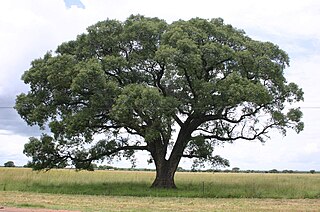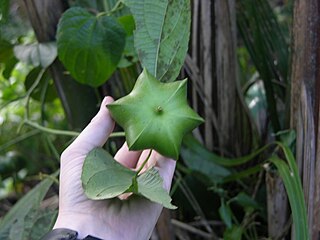
Cola is a carbonated soft drink flavored with vanilla, cinnamon, citrus oils, and other flavorings. Cola became popular worldwide after the American pharmacist John Stith Pemberton invented Coca-Cola, a trademarked brand, in 1886, which was imitated by other manufacturers. Most colas originally contained caffeine from the kola nut, leading to the drink's name, though other sources of caffeine are generally used in modern formulations. The Pemberton cola drink also contained a coca plant extract. His non-alcoholic recipe was inspired by the coca wine of pharmacist Angelo Mariani, created in 1863.

In botany, a fruit is the seed-bearing structure in flowering plants that is formed from the ovary after flowering.

The cashew tree is a tropical evergreen tree native to South America in the genus Anacardium that produces the cashew seed and the cashew apple accessory fruit. The tree can grow as tall as 14 metres, but the dwarf cultivars, growing up to 6 m (20 ft), prove more profitable, with earlier maturity and greater yields. The cashew seed is commonly considered a snack nut eaten on its own, used in recipes, or processed into cashew cheese or cashew butter. Like the tree, the nut is often simply called a cashew. Cashew allergies are triggered by the proteins found in tree nuts, and cooking often does not remove or change these proteins.

Prunus cerasus is a species of Prunus in the subgenus Cerasus (cherries), native to much of Europe, North Africa and West Asia. It is closely related to the sweet cherry, but has a fruit that is more acidic. Its sour pulp is edible.

The kola nut is the seed of certain species of plant of the genus Cola, placed formerly in the cocoa family Sterculiaceae and now usually subsumed in the mallow family Malvaceae. These cola species are trees native to the tropical rainforests of Africa. Their caffeine-containing seeds are about 5 centimetres (2.0 in) across and are used as flavoring ingredients in beverages applied to various carbonated soft drinks, from which the name cola originates.

Sclerocarya birrea, commonly known as the marula, is a medium-sized deciduous fruit-bearing tree, indigenous to the miombo woodlands of Southern Africa, the Sudano-Sahelian range of West Africa, the savanna woodlands of East Africa and Madagascar.

Menispermaceae is a family of flowering plants. The alkaloid tubocurarine, a neuromuscular blocker and the active ingredient in the 'tube curare' form of the dart poison curare, is derived from the South American liana Chondrodendron tomentosum. Several other South American genera belonging to the family have been used to prepare the 'pot' and 'calabash' forms of curare. The family contains 78 genera with some 440 species, which are distributed throughout low-lying tropical areas with some species present in temperate and arid regions.

Tamarindo, also commonly known as agua de tamarindo, is a non-alcoholic beverage made of tamarind, sugar, and water. The tamarind plant originated in India but has since been widely distributed on a global scale and is commonly found in tropical regions. The tamarind plant produces fruit pods containing pulp and seeds. Tamarind is a versatile ingredient that is used for a variety of commercial, culinary and medicinal purposes with the pulp being the most commonly used part of the tamarind plant, used in a range of beverages including tamarindo and other similar beverages such as Nam Ma Kham Wan in Thailand and Poha Beer in Ghana. Tamarind pulp offers a flavour that ranges from sour to sweet, making tamarindo a sour-sweet beverage recognised as a popular flavour of aguas frescas, which is traditionally consumed in Latin America. Comprising only three ingredients, tamarindo involves a simple production process making it an easy beverage to prepare at home. Tamarindo has been produced commercially as a soda flavour, by companies such as Jarritos and Nestle, and distributed globally.

Garcinia kola is a species of flowering plant belonging to the Mangosteen genus Garcinia of the family Clusiaceae. It is found in Benin, Cameroon, The Gambia, Democratic Republic of the Congo, Ivory Coast, Mali, Gabon, Ghana, Liberia, Nigeria, Senegal and Sierra Leone. Its natural habitat is subtropical or tropical moist lowland forests.

Plukenetia volubilis, commonly known as sacha inchi, sacha peanut, mountain peanut, Inca nut or Inca-peanut, is a perennial plant in the family Euphorbiaceae, having small trichomes on its leaves. It is native to much of tropical South America, as well as some of the Windward Islands in the Caribbean. It is cultivated commercially in South East Asia, most notably in Thailand. Although its raw seeds and leaves contain toxins, these components are safe for consumption after roasting.
The following outline is provided as an overview of and topical guide to chocolate:
Delonix edulis (Malagasy:Tara) is a species of edible wild plant native to southwest Madagascar. The plant grows in semi-arid tropical zones with annual rainfall less than 400 mm, from sea level up to 100 meters elevation.

Cola is a genus of trees native to the tropical forests of Africa, classified in the family Malvaceae, subfamily Sterculioideae. Species in this genus are sometimes referred to as kola tree or kola nut for the caffeine-containing fruit produced by the trees that is often used as a flavoring ingredient in beverages. The genus was thought to be closely related to the South American genus Theobroma, or cocoa, but the latter is now placed in a different subfamily. They are evergreen trees, growing up to 20 m tall, with glossy ovoid leaves up to 30 cm long and star-shaped fruit.

Cola nitida is a species of plant belonging to the family Malvaceae.
Cola verticillata is a species of tree in the genus Cola, of the family Malvaceae, native to the forests of tropical Africa. Common names include owe cola, slippery cola and mucilage cola. It was first described by the Danish botanist Peter Thonning as Sterculia verticillata, and was given its current name of Cola verticillata by the Austrian botanist Otto Stapf and the French botanist Auguste Chevalier.

















